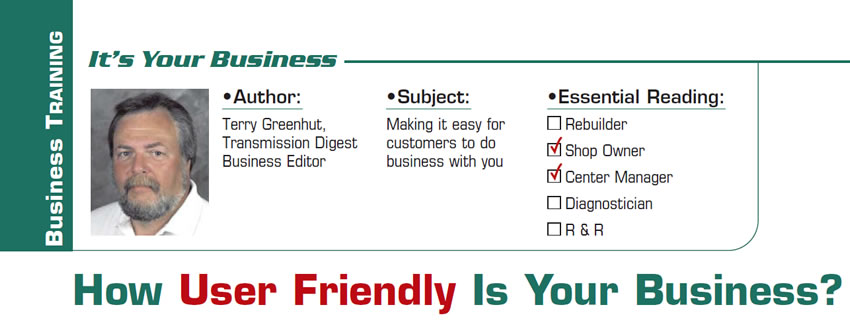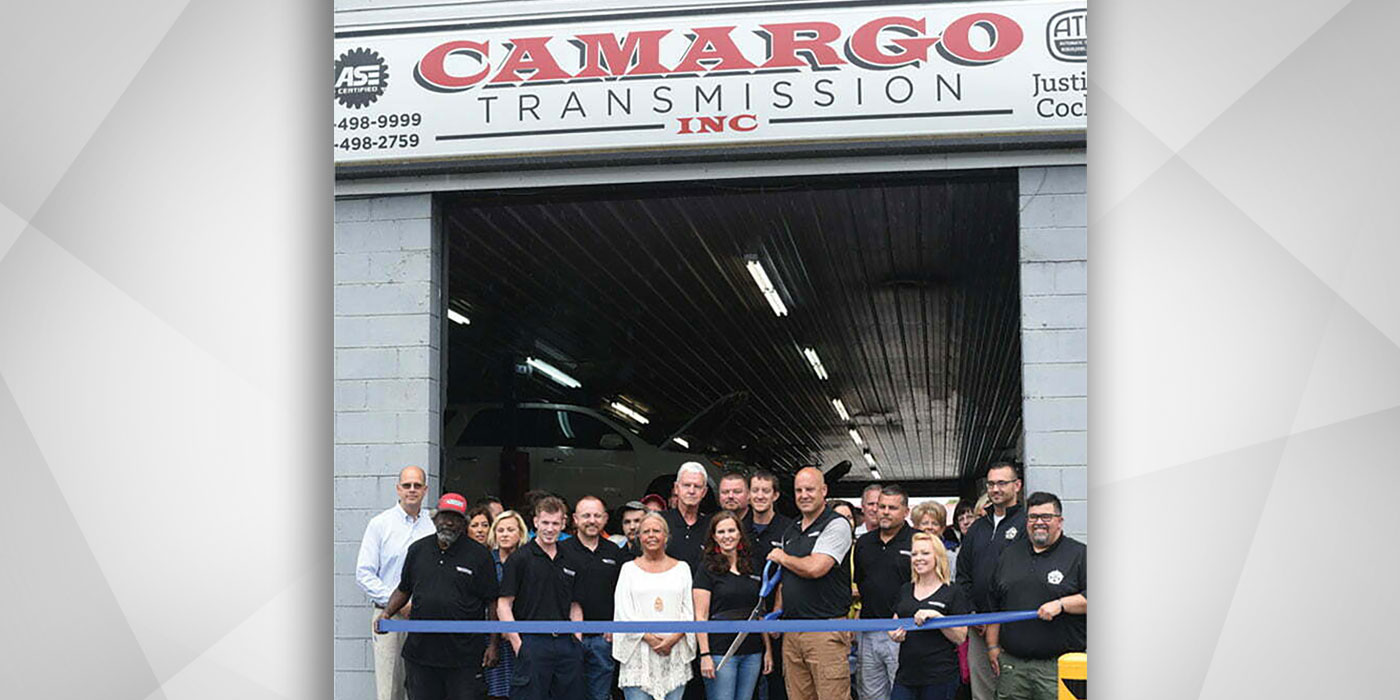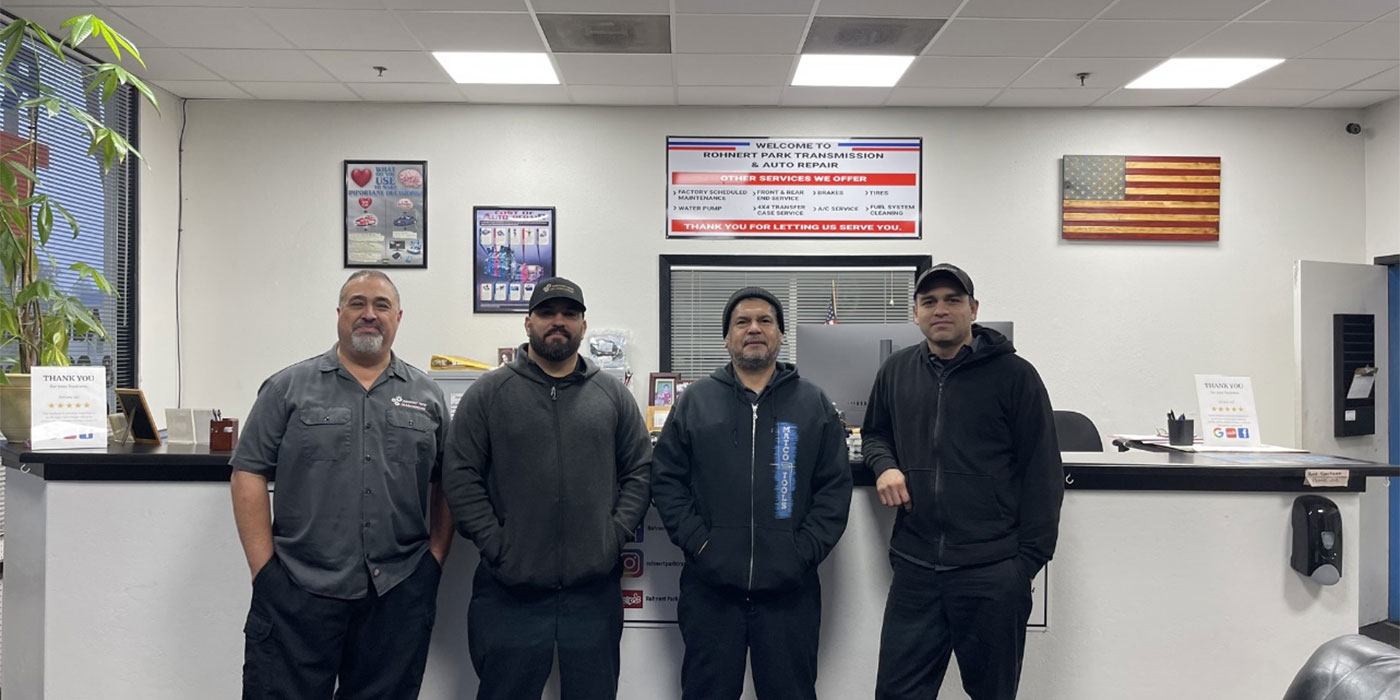
It’s Your Business
- Subject: Making it easy for customers to do business with you
- Essential Reading: Shop Owner, Center Manager
- Author: Terry Greenhut, Transmission Digest Business Editor
The level of service provided to customers is usually mandated by a business owner or very high-level manager. Most of them have lofty ideas as to how they want their customers treated. The problem is that as the customer-service message filters down through the ranks there’s a good chance that it will become diluted, sometimes to a point where it isn’t service at all. When that happens a business is doomed unless it can be turned around, and that can be very difficult after customer trust is destroyed.
Here’s an interesting case to make the point of just how ridiculous customer-service situations can become and how if you don’t have a service representative who cares and has the authority to do what it takes to help customers, situations can go from bad to ugly real quick.
I had a ticket in my hand for a kind of crazy trip that I booked last-minute on a major airline that shall remain nameless. It doesn’t matter, though, because as far as I’m concerned they’re all horrible to one degree or another, so just insert the name you want. Normally when I fly to Denver from New York I go non-stop. It’s one of the few perks of living in a big city like New York that you can still go non-stop to several locales. This time, because I booked so late, all I could get was a one-stop through Dulles International in Washington, D.C., on the way out and a flight through Salt Lake City on the way back, and that was on a different airline.
The day before I was supposed to leave a major hurricane was in the process of traveling up the East Coast. I found out it was due to pass through and around Washington the next morning just about the time my flight was supposed to get there – if, indeed, it had gone at all. Knowing I was in trouble I called the airline to see whether it could reroute me around the storm without charging me an arm and two legs.
At first, a voice that I could barely understand and had to keep asking “What?” told me: “Sure, no problem. We have a flight leaving at 4 p.m. today that will take you to Los Angeles. There you will change planes and fly back to Denver. You should get in about 11 p.m. local time.”
I agreed to the change and was told to hold on while he confirmed it. After I waited on hold at least 10 more minutes the agent got back on the line and told me he was sorry but he could not make the change even though the airline had a hardship policy for these occasions. He said it was because only part of my trip was booked on their airline. I argued that the part that needed to be changed was on their airline. I mentioned that I am a frequent flyer with hundreds of thousands of miles. It didn’t mean a thing. I was told there was nothing they would do for me and that I should contact the online site on which I booked the trip to see whether they could do anything to help.

I proceeded to call Orbitz. Although I had been booking travel with them for the past several years and found it very pleasant to look up flights and make my reservations, I never before had a reason to call them. I wasn’t very hopeful as I dialed the 800 number. A friendly voice answered, one that I could actually understand. When I told him the story he asked what flight I was interested in changing to, then told me to hang on. In about a minute he came back and said: “You’re all set. Be at JFK International at 2 p.m.”
“That’s it?” I asked?
“Yup,” he said. “Nothing to it.”
I asked how he did it. His answer was: “Pressure. You’re an individual; the airline doesn’t really care about the few flights you take with them every year. We, on the other hand, do millions of dollars worth of bookings with them. What they did to you wasn’t right, because they did have a waiver in place for that flight and should have given it to anyone who asked for it, but they do things like that because they can and because there’s no one to stop them. I guess they don’t value an individual customer; we do. Thank you so much for using Orbitz.”
At the end of every flight that airline has a flight attendant get on the P.A. system and say: “We realize you have a choice of airlines. Thank you so much for flying with us.” Well, it’s time for me to exercise my choice, and while I will happily continue to book on Orbitz because its customer service is great, I will do everything in my power to avoid that airline in the future even if it means flying out of my way to do so. They’ve lost a customer out of sheer stupidity and nothing else. How ridiculous. It wouldn’t have cost the airline whether they did it for me or for Orbitz. They wound up doing it anyway and lost a customer in the process.
How hard or easy do you make it for your customers to do business with you? I don’t know whether any of you study businesses as you deal with them. I do. I scrutinize every little thing they do when I am a customer. I’m looking for an experience so enjoyable that I will genuinely want to return over and over again. It’s definitely not easy for a business to maintain such high standards, which is one of the major reasons why customers quit. They get used to a certain performance level and when they believe they are no longer getting it they go look for it elsewhere.
Dealing with customers is always tricky, but there are some basic rules that can keep you on track. The goal is consistency, providing the same or very similar experience every time. Here are some points to consider:
- 1) Try to keep employees with personality disorders away from customers. Bi-polar or depressed individuals go through major mood swings. They’re great one minute and miserable the next. Consistency, therefore, is not part of their repertoire. You need people who are up all the time, who are enthusiastic about dealing with customers and making them happy.
- 2) Understand that your primary concern is to make the business a success and keep it that way. To do that it has to make money. A profit must be made on each job, other than the occasional loss leader designed to bring new customers in, so your level of customer service can’t take you to the point where you lose money on jobs just to get them in the door. You must reach a happy medium as to how far you will go to keep a customer. The question: Is this customer worth what I will have to invest? In some instances you won’t know on the first job – or maybe even the second or third. You might not make money with this person immediately, but you can’t turn right around and cancel him out. It costs you too much to bring him in. In time, if you find the relationship to be one-sided, if you aren’t making money or getting the referrals you need, dump him and move on. The best way to dump a customer is to simply price him out of your life. When the price gets so high that he is no longer willing to pay, he’s done, and this type of customer probably won’t stand for the first price increase, so it won’t take long.
- 3) Be open when they need you. Although it’s nice to have weekends off, we have to realize that many of our customers can get things accomplished only on weekends. Their jobs prohibit them from taking care of their personal business during the work week. Some shops are in areas where there just isn’t any activity on a Saturday. Others seem to have it as their busiest day of the week. Your business hours need to accommodate your customers as well. Are you there early enough and do you stay late enough to make it convenient for drop-off and pickup?
- 4) Most of us like to have customers drop off cars rather than wait. If you want them to do that you may need to have a driver on the payroll at least part time to take customers home or to work and bring them back later when their cars are ready.
- 5) The word “NO” should be stricken from the company vocabulary. “YES” or some form of it must be adopted: “Yes, we can take care of that for you.” “Yes, you can bring it in this afternoon.” “Yes, I can give you a price on that just as soon as my technician has a look at it,” as opposed to “No, we don’t give prices over the telephone.”
- 6) In a comeback situation act as though you are thrilled that they brought this problem to your attention, then take care of it as quickly as possible. Remember that this customer has already paid you and deserves to have the car fixed right and without delay.
- 7) Have as many payment options available as possible. Even though some of the credit-card companies take a little higher percentage from you, refusing to accept a major credit card can be a disaster, especially if it’s the only card the customer has or has enough room on it for the purchase. Getting the money in your hand without causing the customer grief is worth the extra point or two you might have to pay.
The success of your business depends on how much customers like and trust you and your staff. If you give them a good job at a fair price in a clean facility using a pleasant and caring manner, they will help you to become and remain as successful as you want to be.

Terry Greenhut, Transmission Digest Business Editor. Visit www.TerryGreenhut.com.













